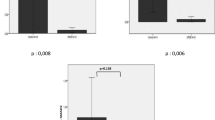Abstract
Introduction and hypothesis
The pathophysiology of pelvic organ prolapse (POP) is related to aging in the pelvic organ support, and mitochondrial dysfunction is one of the major contributors to aging. Therefore, the objective of this study was to investigate the correlation between alternations of mitochondrial DNA and progression of POP.
Methods
Polymerase chain reaction (PCR) was applied in the present study. Uterosacral ligaments (UL) were obtained from 45 POP patients and 38 myoma patients without POP. Chi-square test, Student’s t-test, Mann–Whitney U test, and Spearman correlation analysis were applied in the comparison between POP and non-POP patients.
Results
The results revealed that significant depletion of mitochondrial DNA (mtDNA) and an increase in the incidence of 4977 deletion of mtDNA (mtDNA4977) in the UL tissue of POP patients.
Conclusions
The alternations of mtDNA may play an important role in the molecular pathogenesis and process of POP formation.




Similar content being viewed by others
Abbreviations
- POP:
-
pelvic organ prolapse
- QPCR:
-
quantitative polymerase chain reaction
- UL:
-
uterosacral ligaments
- mtDNA:
-
mitochondrial DNA
- mtDNA4977:
-
4977 deletion of mitochondrial DNA
- BMI:
-
body-mass index
References
Jelovsek JE, Maher C, Barber MD (2007) Pelvic organ prolapse. Lancet 369:1027–1038
Jelovsek JE, Barber MD (2006) Women seeking treatment for advanced pelvic organ prolapse have decreased body image and quality of life. Am J Obstet Gynecol 194:1455–1461
Samuelsson EC, Victor FT, Tibblin G, Svardsudd KF (1999) Signs of genital prolapse in a Swedish population of women 20 to 59 years of age and possible related factors. Am J Obstet Gynecol 180:299–305
Mant J, Painter R, Vessey M (1997) Epidemiology of genital prolapse: observations from the Oxford Family Planning Association Study. Br J Obstet Gynaecol 104:579–585
Olsen AL, Smith VJ, Bergstrom JO, Colling JC, Clark AL (1997) Epidemiology of surgically managed pelvic organ prolapse and urinary incontinence. Obstet Gynecol 89:501–506
Ulmsten U, Ekman G, Giertz G, Malmstrom A (1987) Different biochemical composition of connective tissue in continent and stress incontinent women. Acta Obstet Gynecol Scand 66:455–457
Harman D (1972) The biologic clock: the mitochondria? J Am Geriatr Soc 20:145–147
Graff C, Clayton DA, Larsson NG (1999) Mitochondrial medicine–recent advances. J Intern Med 246:11–23
Drew B, Leeuwenburgh C (2004) Ageing and subcellular distribution of mitochondria: role of mitochondrial DNA deletions and energy production. Acta Physiol Scand 182:333–341
Kajander OA, Rovio AT, Majamaa K, Poulton J, Spelbrink JN, Holt IJ, Karhunen PJ, Jacobs HT (2000) Human mtDNA sublimons resemble rearranged mitochondrial genoms found in pathological states. Hum Mol Genet 9:2821–2835
Wei YH (1992) Mitochondrial DNA alterations as ageing-associated molecular events. Mutat Res 275:145–155
Bump RC, Mattiasson A, Bo K, Brubaker LP, DeLancey JO, Klarskov P, Shull BL, Smith AR (1996) The standardization of terminology of female pelvic organ prolapse and pelvic floor dysfunction. Am J Obstet Gynecol 175:10–17
Liu CS, Tsai CS, Kuo CL, Chen HW, Lii CK, Ma YS, Wei YH (2003) Oxidative stress-related alteration of the copy number of mitochondrial DNA in human leukocytes. Free Radic Res 37:1307–1317
Kang D, Hamasaki N (2005) Alterations of mitochondrial DNA in common diseases and disease states: aging, neurodegeneration, heart failure, diabetes, and cancer. Curr Med Chem 12:429–441
Pesce V, Cormio A, Marangi LC, Guglielmi FW, Lezza AM, Francavilla A, Cantatore P, Gadaleta MN (2002) Depletion of mitochondrial DNA in the skeletal muscle of two cirrhotic patients with severe asthenia. Gene 286:143–148
Liu CS, Cheng WL, Lee CF, Ma YS, Lin CY, Huang CC, Wei YH (2006) Alteration in the copy number of mitochondrial DNA in leukocytes of patients with mitochondrial encephalomyopathies. Acta Neurol Scand 113:334–341
Hou JH, Wei YH (1996) The unusual structures of the hot-regions flanking large-scale deletions in human mitochondrial DNA. Biochem J 318(Pt 3):1065–1070
Wallace DC (1992) Mitochondrial genetics: a paradigm for aging and degenerative diseases? Science 256:628–632
Mohamed SA, Hanke T, Erasmi AW, Bechtel MJ, Scharfschwerdt M, Meissner C, Sievers HH, Gosslau A (2006) Mitochondrial DNA deletions and the aging heart. Exp Gerontol 41:508–517
Acknowledgments
The authors wish to thank Chih-Cheng Huang, MD, Man-Chi Lo, MD, and the Changhua Christian Hospital, Changhua, Taiwan, for their cooperation and assistance with this study.
Conflicts of interest
None.
Author information
Authors and Affiliations
Corresponding authors
Rights and permissions
About this article
Cite this article
Sun, MJ., Cheng, WL., Wei, YH. et al. Low copy number and high 4977 deletion of mitochondrial DNA in uterosacral ligaments are associated with pelvic organ prolapse progression. Int Urogynecol J 20, 867–872 (2009). https://doi.org/10.1007/s00192-009-0871-4
Received:
Accepted:
Published:
Issue Date:
DOI: https://doi.org/10.1007/s00192-009-0871-4




